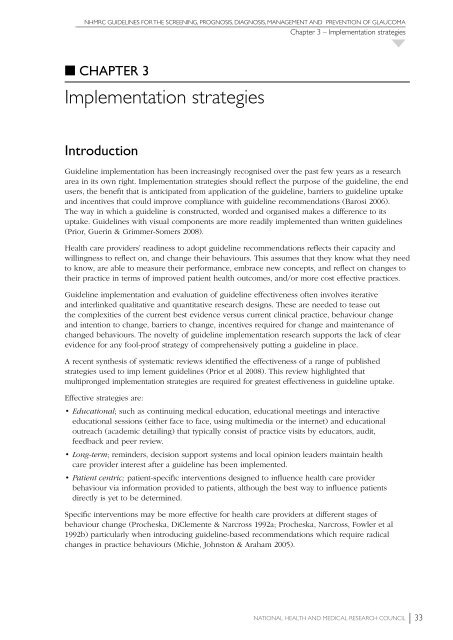NHMRC Glaucoma Guidelines - ANZGIG
NHMRC Glaucoma Guidelines - ANZGIG
NHMRC Glaucoma Guidelines - ANZGIG
Create successful ePaper yourself
Turn your PDF publications into a flip-book with our unique Google optimized e-Paper software.
<strong>NHMRC</strong> GUIDELINES FOR THE SCREENING, PROGNOSIS, DIAGNOSIS, MANAGEMENT AND PREVENTION OF GLAUCOMA<br />
Chapter 3 – Implementation strategies<br />
■ Chapter 3<br />
Implementation strategies<br />
Introduction<br />
Guideline implementation has been increasingly recognised over the past few years as a research<br />
area in its own right. Implementation strategies should reflect the purpose of the guideline, the end<br />
users, the benefit that is anticipated from application of the guideline, barriers to guideline uptake<br />
and incentives that could improve compliance with guideline recommendations (Barosi 2006).<br />
The way in which a guideline is constructed, worded and organised makes a difference to its<br />
uptake. <strong>Guidelines</strong> with visual components are more readily implemented than written guidelines<br />
(Prior, Guerin & Grimmer-Somers 2008).<br />
Health care providers’ readiness to adopt guideline recommendations reflects their capacity and<br />
willingness to reflect on, and change their behaviours. This assumes that they know what they need<br />
to know, are able to measure their performance, embrace new concepts, and reflect on changes to<br />
their practice in terms of improved patient health outcomes, and/or more cost effective practices.<br />
Guideline implementation and evaluation of guideline effectiveness often involves iterative<br />
and interlinked qualitative and quantitative research designs. These are needed to tease out<br />
the complexities of the current best evidence versus current clinical practice, behaviour change<br />
and intention to change, barriers to change, incentives required for change and maintenance of<br />
changed behaviours. The novelty of guideline implementation research supports the lack of clear<br />
evidence for any fool-proof strategy of comprehensively putting a guideline in place.<br />
A recent synthesis of systematic reviews identified the effectiveness of a range of published<br />
strategies used to imp lement guidelines (Prior et al 2008). This review highlighted that<br />
multipronged implementation strategies are required for greatest effectiveness in guideline uptake.<br />
Effective strategies are:<br />
• Educational; such as continuing medical education, educational meetings and interactive<br />
educational sessions (either face to face, using multimedia or the internet) and educational<br />
outreach (academic detailing) that typically consist of practice visits by educators, audit,<br />
feedback and peer review.<br />
• Long-term; reminders, decision support systems and local opinion leaders maintain health<br />
care provider interest after a guideline has been implemented.<br />
• Patient centric; patient-specific interventions designed to influence health care provider<br />
behaviour via information provided to patients, although the best way to influence patients<br />
directly is yet to be determined.<br />
Specific interventions may be more effective for health care providers at different stages of<br />
behaviour change (Procheska, DiClemente & Narcross 1992a; Procheska, Narcross, Fowler et al<br />
1992b) particularly when introducing guideline-based recommendations which require radical<br />
changes in practice behaviours (Michie, Johnston & Araham 2005).<br />
National Health and Medical Research Council 33





